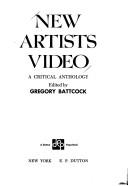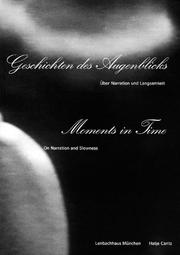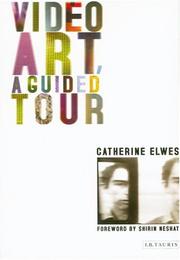| Listing 1 - 10 of 78 | << page >> |
Sort by
|

ISBN: 0525474617 Year: 1978 Publisher: New York Dutton
Abstract | Keywords | Export | Availability | Bookmark
 Loading...
Loading...Choose an application
- Reference Manager
- EndNote
- RefWorks (Direct export to RefWorks)
Art video --- Video art --- Videokunst --- Video art. --- Addresses, essays, lectures. --- Art vidéo --- Art électronique --- Electronic art --- Experimental television --- Vidéo expérimentale --- Vidéo formelle --- Vidéo-art

ISBN: 3893229833 Year: 1999 Publisher: Ostfildern : Hatje Cantz,
Abstract | Keywords | Export | Availability | Bookmark
 Loading...
Loading...Choose an application
- Reference Manager
- EndNote
- RefWorks (Direct export to RefWorks)
Coleman, James ; Dean, Tacita ; Douglas, Stan ; Gordon, Douglas ; McQueen, Steve ; Nauman, Bruce ; Trockel, Rosemarie ; Viola, Bill
Video art --- Art, Modern --- Art vidéo --- Art --- Exhibitions. --- Expositions --- -Video art --- Electronic art --- Experimental television --- Performance art --- Television --- Experimental films --- Modern art --- Art vidéo
Book
ISBN: 9781904864509 1904864503 Year: 2008 Publisher: Birmingham Manchester Ikon Gallery
Abstract | Keywords | Export | Availability | Bookmark
 Loading...
Loading...Choose an application
- Reference Manager
- EndNote
- RefWorks (Direct export to RefWorks)
Art, Modern --- Video art --- Lange, Darcy, --- Exhibitions --- Electronic art --- Experimental television --- Performance art --- Television --- Experimental films --- Time-based art --- Campana, Paco
Book
ISBN: 1299485405 0773589007 9780773589001 0773541691 9780773541696 0773541691 9780773541696 9781299485402 9780773589018 0773589015 Year: 2013 Publisher: Montreal : McGill-Queen's University Press,
Abstract | Keywords | Export | Availability | Bookmark
 Loading...
Loading...Choose an application
- Reference Manager
- EndNote
- RefWorks (Direct export to RefWorks)
The Video Art of Sylvia Safdie brings into focus the complete video oeuvre of a pioneering Canadian artist. Tracing the development of Safdie's work and its implications for the future of media art, this volume provides a stunning perspective on her videos and sets a new standard for the presentation of video art in book form. Safdie's principal video works are presented in the form of more than 200 images, selected and arranged to suggest the content, rhythm, and movement of the videos themselves. Alongside the rich illustrations, the book explores Safdie's video art through a thoughtful introduction to the artist and two insightful critical essays. Eric Lewis relates her videos to her works in other media, considers how she poses key questions in the philosophy of art, and addresses issues concerning Jewish art and identity. He discusses the complex relationship between Safdie's video images and the improvised music she often employs as soundtracks. An essay by music scholar and conductor Eleanor Stubley explores the relationship between the body and mind in Safdie's videos, shedding light on the emotive and sensorial qualities of the breathing body. A vibrant appeal to both the eye and the mind, The Video Art of Sylvia Safdie showcases an artist at the vanguard of video and intermedia art and demonstrates how her work is representative of the next stage in artistic explorations of time, change, corporeality, and our place in nature.
Video art --- Electronic art --- Experimental television --- Art, Modern --- Performance art --- Television --- Experimental films --- Safdie, Sylvia, --- Criticism and interpretation. --- Time-based art
Book
ISBN: 1283637766 1846381118 9781846381119 9781846380853 1846380855 9781846380860 1846380863 9781283637763 184638110X Year: 2012 Publisher: London : Afterall Books,
Abstract | Keywords | Export | Availability | Bookmark
 Loading...
Loading...Choose an application
- Reference Manager
- EndNote
- RefWorks (Direct export to RefWorks)
An illustrated exploration of a groundbreaking work and its connections to New York's art and music scenes of the 1980s.
Conceptual art --- Video art --- Electronic art --- Experimental television --- Art, Modern --- Performance art --- Television --- Experimental films --- Graham, Dan, --- Graham, Daniel H., --- Gureamu, Dan, --- Criticism and interpretation. --- Time-based art
Book
ISBN: 1630872687 9781630872687 1620324717 9781620324714 Year: 2014 Publisher: Eugene, Oregon : Pickwick Publications,
Abstract | Keywords | Export | Availability | Bookmark
 Loading...
Loading...Choose an application
- Reference Manager
- EndNote
- RefWorks (Direct export to RefWorks)
The breach of art from religion is just one of the many unhappy legacies of modernism. There was a time, however, when the aesthetic and the spiritual were of a piece. This study of the work of American video artist Bill Viola considers the possible reemergence of a theological dimension to contemporary art--a reenchantment of art, as some have called it. Using the high-tech apparatus of modern video, Viola's art is rooted precisely in this theological tradition of transcendent mystical experience and spiritual self-concentration. The technological apotheosis of modern image-making--high speed film, high-definition video, LCD and plasma screens, and sophisticated sound recording--are put to use by Viola in ways that significantly challenge prevailing intellectual and artistic traditions and return us to the power of the Sublime--that which, by definition, defeats language. Viola's art as such converges with postmodern notions of the unrepresentable and with the ancient theological tradition of apophasis, speaking away or unsaying. The fullness of meaning, then, appears only as a promise of presence through embodied absence, neither fully here and now nor entirely elsewhere and beyond. This study seeks to define, through the work of a courageous and thoughtful contemporary artist, the theological sublime as an aesthetic of revelation.
Video art --- Electronic art --- Experimental television --- Art, Modern --- Performance art --- Television --- Experimental films --- Viola, Bill, --- Criticism and interpretation. --- Time-based art
Book
ISBN: 0199978565 1299485308 0199861412 9780199861415 9781299485303 9780199332731 0199332738 9780199861422 0199861420 9780199861408 0199861404 Year: 2013 Publisher: Oxford ; New York : Oxford University Press,
Abstract | Keywords | Export | Availability | Bookmark
 Loading...
Loading...Choose an application
- Reference Manager
- EndNote
- RefWorks (Direct export to RefWorks)
Becoming commercially available in the mid 1960s, video quickly became integral to the intense experimentalism of New York City's music and art scenes. The medium was able to record image and sound at the same time, which allowed composers to visualize their music and artists to sound their images. But as well as creating unprecedented forms of audiovisuality, video work also producedinteractive spaces that questioned conventional habits of music and art consumption. This book explores the first decade of creative video work, focusing on the ways in which video technology was used to dissolve the boundaries between art and music.
Music --- Video art. --- Electronic art --- Experimental television --- Art, Modern --- Performance art --- Television --- Time-based art --- Experimental films --- History and criticism. --- Video Art --- Art
Book
ISBN: 1438468954 9781438468952 9781438468938 Year: 2018 Publisher: Albany, New York : State University of New York Press,
Abstract | Keywords | Export | Availability | Bookmark
 Loading...
Loading...Choose an application
- Reference Manager
- EndNote
- RefWorks (Direct export to RefWorks)
Hailed as "the most consequential artist to have emerged since the nineteen-eighties," American artist and filmmaker Ryan Trecartin has received numerous accolades for his kaleidoscopic, multilayered movies and multimedia installations. However, there exists to date no comprehensive study of this prolific artist's work. Queer Art Camp Superstar compensates for this absence of sustained critical analysis of Trecartin's work by looking closely at a selection of his most significant movies in order to discern the artist's artistic genealogy, evolving aesthetics, radical approach to digital and Internet culture, and impact on contemporary art, film, and media.Examining Trecartin's substantial body of work, spanning from his early, pre-YouTube era series Early Baggage (2001–2003) to Temple Time (2016), Ricardo E. Zulueta adheres to a faithful chronological order, thus inviting readers to witness the ways thematic and formal concerns have evolved from Trecartin's earliest movies to his more recent multimedia cinematic installations. Through precisely chosen screen captures extracted directly from the movies, Zulueta demonstrates the serious attention paid to camera angles, mise-en-scène, and shot transitions, thus revealing and reflecting on the concepts that underwrite and are underwritten in these narratives. Giving careful attention to Trecartin's network of layered references to the grotesque and abject, carnivalesque and ludic, and camp imagery, Zulueta illustrates and explains how the artist takes on reality television, technology, fashion, consumption, and cyberspace.
Video art --- Electronic art --- Experimental television --- Art, Modern --- Performance art --- Television --- Experimental films --- History and criticism. --- Trecartin, Ryan, --- Criticism and interpretation. --- Time-based art
Book
ISBN: 9042008113 9004495002 9789042008113 9789004495005 Year: 2000 Publisher: Amsterdam ; Atlanta, Georgia : Rodopi,
Abstract | Keywords | Export | Availability | Bookmark
 Loading...
Loading...Choose an application
- Reference Manager
- EndNote
- RefWorks (Direct export to RefWorks)
In the 21st century, the screen - the Internet screen, the television screen, the video screen and all sorts of combinations thereof - will be booming in our visual and infotechno culture. Screen-based art, already a prominent and topical part of visual culture in the 1990s, will expand even more. In this volume, digital art - the new media - as well as its connectedness to cinema will be the subject of investigation. The starting point is a two-day symposium organized by the Netherlands Media Art Institute Montevideo/TBA, in collaboration with the L&B (Lier en Boog) series and the Amsterdam School of Cultural Analysis (ASCA). Issues which emerged during the course of investigation deal with questions such as: How could screen-based art be distinguished from other art forms? Could screen-based art theoretically be understood in one definite model or should one search for various possibilities and/or models? Could screen-based art be canonized? What are the physical and theoretical forms of representation for screen-based art? What are the idiosyncratic concepts geared towards screen-based art? This volume includes various arguments, positions, and statements by artists, curators, philosophers, and theorists. The participants are Marie-Luise Angerer, Annette W. Balkema, René Beekman, Raymond Bellour, Peter Bogers, Joost Bolten, Noël Carroll, Sean Cubitt, Cãlin Dan, Chris Dercon, Honoré d'O, Anne-Marie Duquet, Ken Feingold, Ursula Frohne, hARTware curators, Heiner Holtappels, Aernout Mik, Patricia Pisters, Nicolaus Schafhausen, Jeffrey Shaw, Peter Sloterdijk, Ed S. Tan, Barbara Visser and Siegfried Zielinski.
Video art. --- Electronic art --- Experimental television --- Art, Modern --- Performance art --- Television --- Time-based art --- Experimental films --- Art and motion pictures --- Video art

ISBN: 1850435464 9781850435464 Year: 2005 Publisher: London : Tauris,
Abstract | Keywords | Export | Availability | Bookmark
 Loading...
Loading...Choose an application
- Reference Manager
- EndNote
- RefWorks (Direct export to RefWorks)
Art video --- Video art --- Videokunst --- Art, Modern --- Video art. --- Art vidéo --- Art --- Art électronique --- Electronic art --- Experimental television --- Vidéo expérimentale --- Vidéo formelle --- Vidéo-art --- Art [Modern ] --- 20th century --- Art vidéo.
| Listing 1 - 10 of 78 | << page >> |
Sort by
|

 Search
Search Feedback
Feedback About UniCat
About UniCat  Help
Help News
News